power steering CADILLAC CATERA 1997 1.G Owners Manual
[x] Cancel search | Manufacturer: CADILLAC, Model Year: 1997, Model line: CATERA, Model: CADILLAC CATERA 1997 1.GPages: 338, PDF Size: 18.02 MB
Page 77 of 338

Downloaded from www.Manualslib.com manuals search engine OFF (I): This position lets you turn off the engine but
still turn the steering wheel. It doesn’t lock the steering
wheel like
LOCK. Use OFF if you must have your
vehicle in motion while the engine
is off (for example, if
your vehicle is being pushed).
RUN (11): The ignition is on in this position. RUN is
used for driving your vehicle.
START (III): This position starts the engine.
To lock the steering column, remove the key while in
LOCK. Rotate the steering wheel until you hear a click.
Retained Accessory Power
The radio is the only accessory on your Catera that may
be used
for up to 10 minutes after the ignition is turned
to OFF.
Power to the fuel door, trunk release and door locks is
available at all times. The power window controls and the
sunroof controls are active until a door is opened
-- there
is no time limit as long as the doors remain closed.
Starting Your Engine
Move your shift lever to PARK (P) or NEUTRAL (N).
Your engine won’t start in any other position -- that’s a
safety feature. To restart when you’re already moving,
use NEUTRAL
(N) only.
NOTICE:
Don’t try to shift to PARK (P) if your Catera
is moving. If you do, you could damage the
transmission. Shift to PARK
(P) only when your
vehicle is stopped.
1. Without pushing the accelerator pedal, turn your
ignition key to START. When the engine starts, let
go of the key. The idle speed will
go down as your
engine gets warm.
NOTICE:
Holding your key in START for longer than
15 seconds at a time will cause your battery to be
drained much sooner. And the excessive heat can
damage your starter motor.
2. If it doesn’t start right away, hold your key in
START for about three seconds at a time until your
engine starts. Wait about
15 seconds between each
try to help avoid draining your battery.
Page 92 of 338
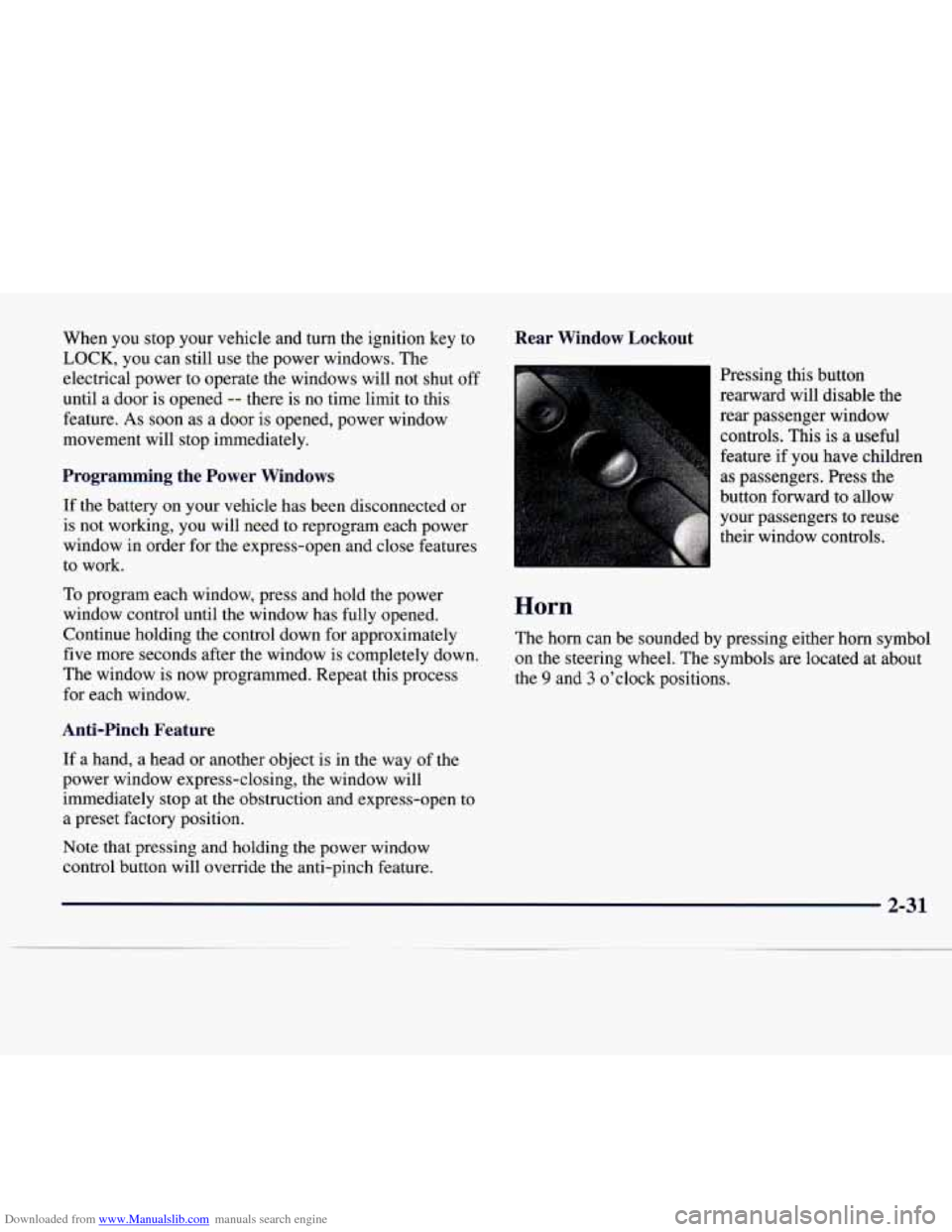
Downloaded from www.Manualslib.com manuals search engine When you stop your vehicle and turn the ignition key to
LOCK, you can still use the power windows. The
electrical power to operate the windows will not shut off
until a door is opened
-- there is no time limit to this
feature.
As soon as a door is opened, power window
movement will stop immediately.
Programming the Power Windows
If the battery on your vehicle has been disconnected or
is not working, you will need to reprogram each power
window in order for the express-open and close features
to work.
To program each window, press and hold the power
window control until the window has fully opened.
Continue holding the control down for approximately
five more seconds after the window is completely down.
The window is now programmed. Repeat this process
for each window.
Anti-Pinch Feature
If a hand, a head or another object is in the way of the
power window express-closing, the window will
immediately stop at the obstruction and express-open to
a preset factory position.
Note that pressing and holding the power window
control button will override the anti-pinch feature.
Rear Window Lockout
Pressing this button
rearward will disable the
rear passenger window
controls. This is a useful
feature if you have children
as passengers.
Press the
button forward to allow
your passengers to reuse
their window controls.
Horn
The horn can be sounded by pressing either horn symbol
on the steering wheel. The symbols are located at about
the
9 and 3 o’clock positions.
Page 177 of 338
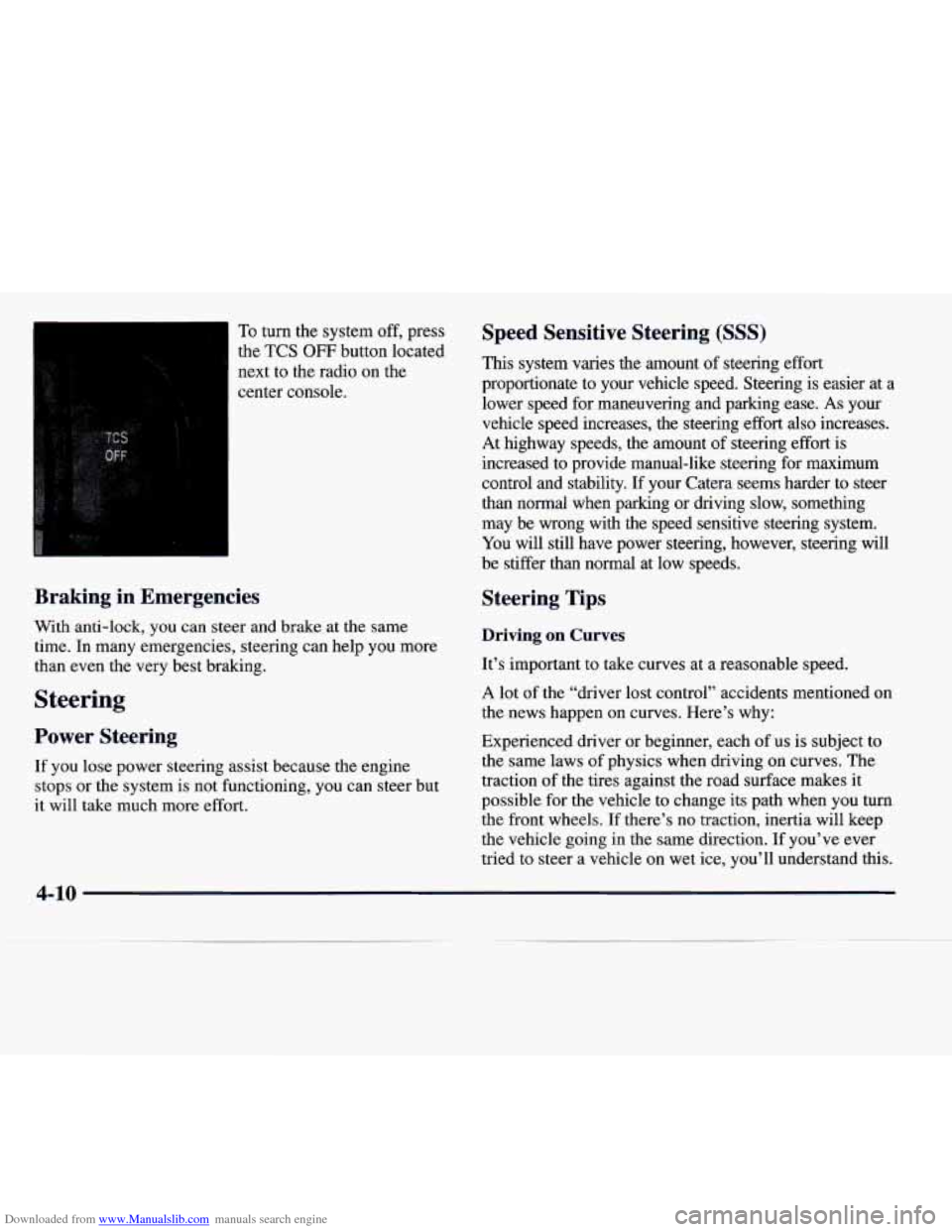
Downloaded from www.Manualslib.com manuals search engine To turn the system off, press
the
TCS OFF button located
next to the radio on the
center console.
b
Braking in Emergencies
With anti-lock, you can steer and brake at the same
time. In many emergencies, steering can help
you more
than even the very best braking.
Steering
Power Steering
If you lose power steering assist because the engine
stops or the system is not functioning, you
can steer but
it will take much more effort.
Speed Sensitive Steering (SSS)
This system varies the amount of steering effort
proportionate to your vehicle speed. Steering is
easier at a
lower speed for maneuvering and parking ease. As your
vehicle speed increases, the steering
effort also increases.
At highway speeds, the amount of steering
effort is
increased to provide manual-like steering for maximum
control and stability.
If your Catera seems harder to steer
than normal when parking or driving slow, something
may be wrong with the speed sensitive steering
system.
You will still have power steering, however, steering will
be stiffer than normal at low speeds.
Steering Tips
Driving on Curves
It’s important to take curves at a reasonable speed.
A lot of the “driver lost control” accidents mentioned on
the news happen on curves. Here’s why:
Experienced driver or beginner, each
of us is subject to
the same laws of physics when driving on curves. The
traction
of the tires against the road surface makes it
possible for the vehicle to change its path when you turn
the front wheels.
If there’s no traction, inertia will keep
the vehicle going in the same direction.
If you’ve ever
tried to steer a vehicle on wet ice, you’ll understand this.
4-10
Page 252 of 338
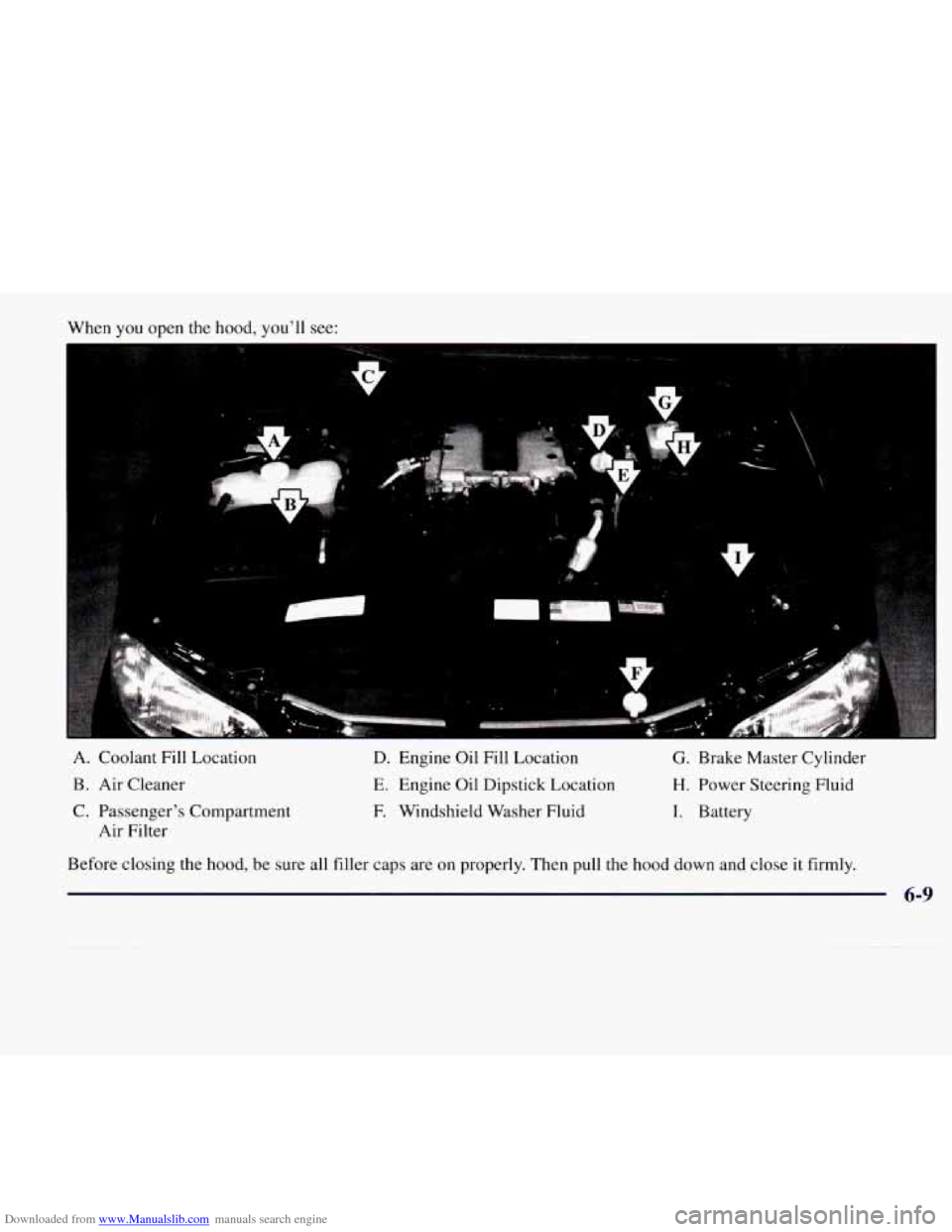
Downloaded from www.Manualslib.com manuals search engine When you open the hood, you’ll see:
1
H
A. Coolant Fill Location D. Engine Oil Fill Location G. Brake Master Cylinder
B. Air Cleaner E. Engine Oil Dipstick Location H. Power Steering Fluid
C. Passenger’s Compartment
F. Windshield Washer Fluid I. Battery
Air Filter
Before closing the hood,
be sure all filler caps are on properly. Then pull the hood down and close it firmly.
6-9
Page 266 of 338
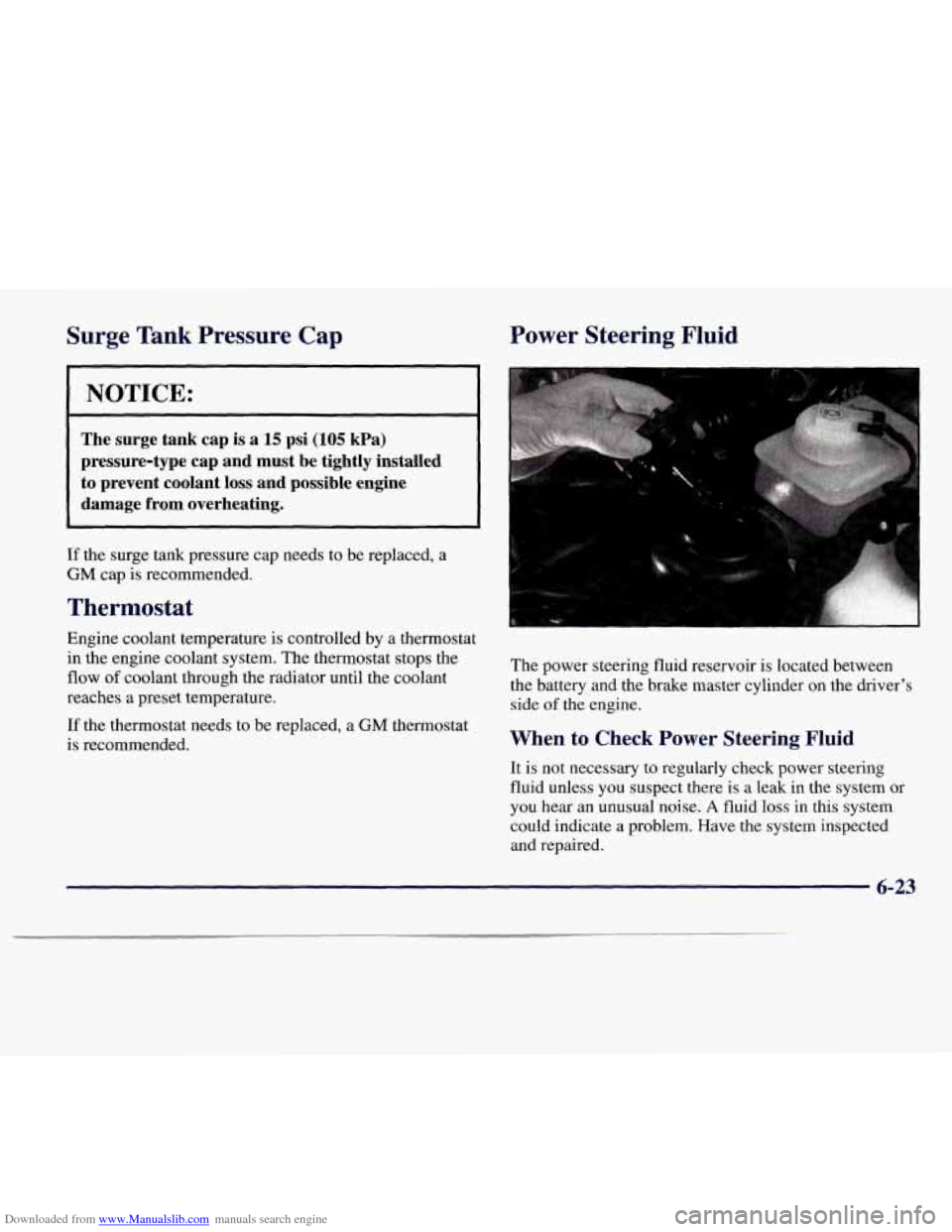
Downloaded from www.Manualslib.com manuals search engine Surge Tank Pressure Cap Power Steering Fluid
NOTICE:
The surge tank cap is a 15 psi (105 kPa)
pressure-type cap and must be tightly installed to prevent coolant loss and possible engine
damage from overheating.
If the surge tank pressure cap needs to be replaced, a
GM cap is recommended.
Thermostat
Engine coolant temperature is controlled by a thermostat
in the engine coolant system. The thermostat stops the
flow
of coolant through the radiator until the coolant
reaches a preset temperature.
If the thermostat needs to be replaced, a GM thermostat
is recommended. The
power steering fluid reservoir
is located between
the battery and the brake master cylinder on the driver’
side
of the engine.
When to Check Power Steering Fluid
It is not necessary to regularly check power steering
fluid unless you suspect there is a leak in the system or
you hear an unusual noise. A fluid loss in this system
could indicate a problem. Have the system inspected
and repaired.
6-23
Page 267 of 338
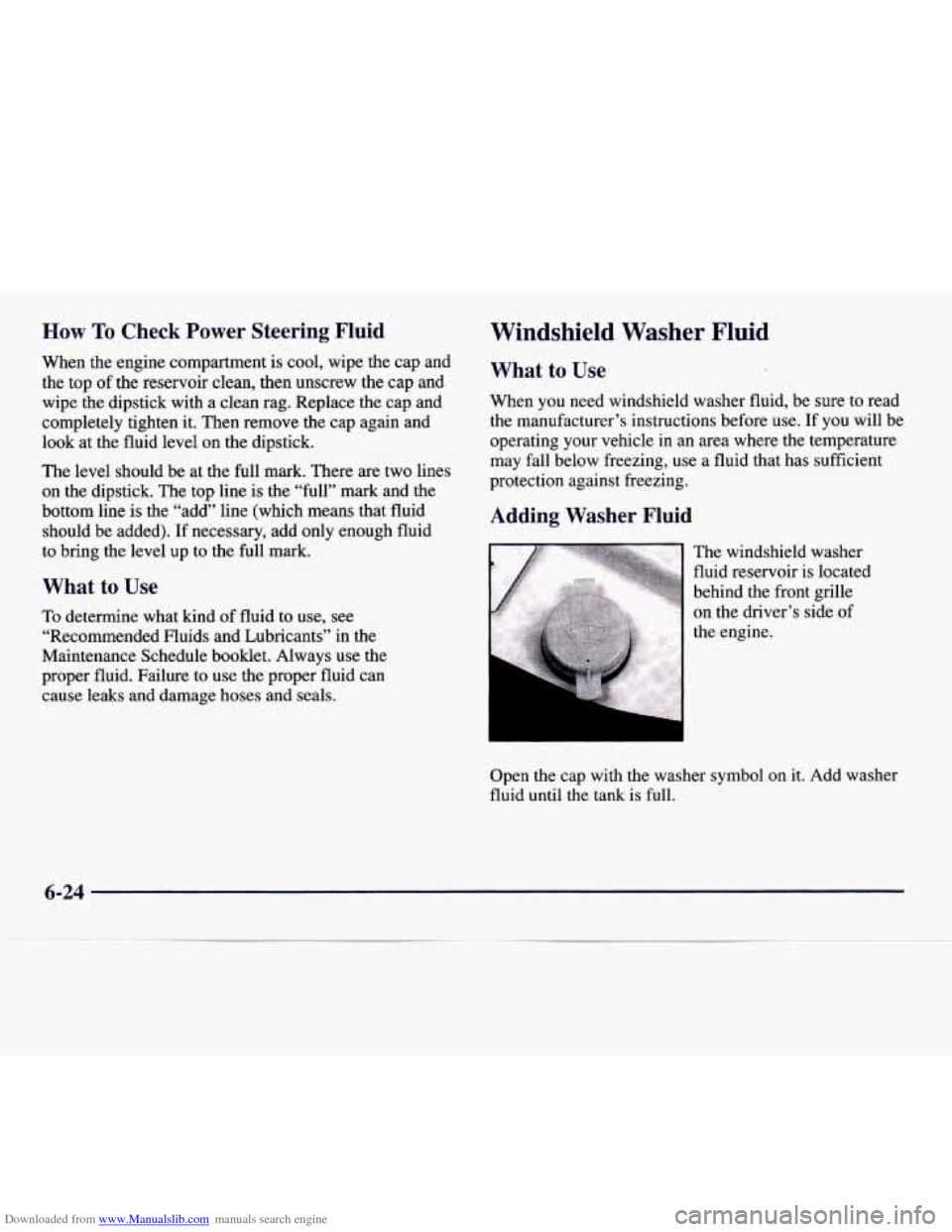
Downloaded from www.Manualslib.com manuals search engine Mow To Check Power Steering Fluid
When the engine compartment is cool, wipe the cap and
the top of the reservoir clean, then unscrew the cap and
wipe the dipstick with a clean rag. Replace the cap and
completely tighten it. Then remove the cap again and
look at the fluid level on the dipstick.
The level should be at the full mark. There are two lines
on the dipstick. The top line is the “full” mark and the
bottom
line is the “add” line (which means that fluid
should be added). If necessary, add only enough fluid
to bring the level up to the
full mark.
What to Use
To determine what kind of fluid to use, see
“Recommended Fluids and Lubricants” in the
Maintenance Schedule booklet. Always use the
proper fluid. Failure to use the proper fluid can
cause leaks and damage hoses and seals.
Windshield Washer Fluid
What to Use
When you need windshield washer fluid, be sure to read
the manufacturer’s instructions before use. If you will be
operating your vehicle
in an area where the temperature
may fall below freezing, use a fluid that has sufficient
protection against freezing.
Adding Washer Fluid
The windshield washer
fluid reservoir is located
behind the front grille
on the driver’s side
of
the engine.
Open the cap with the washer symbol on it. Add washer
fluid until
the tank is full.
6-24
Page 301 of 338
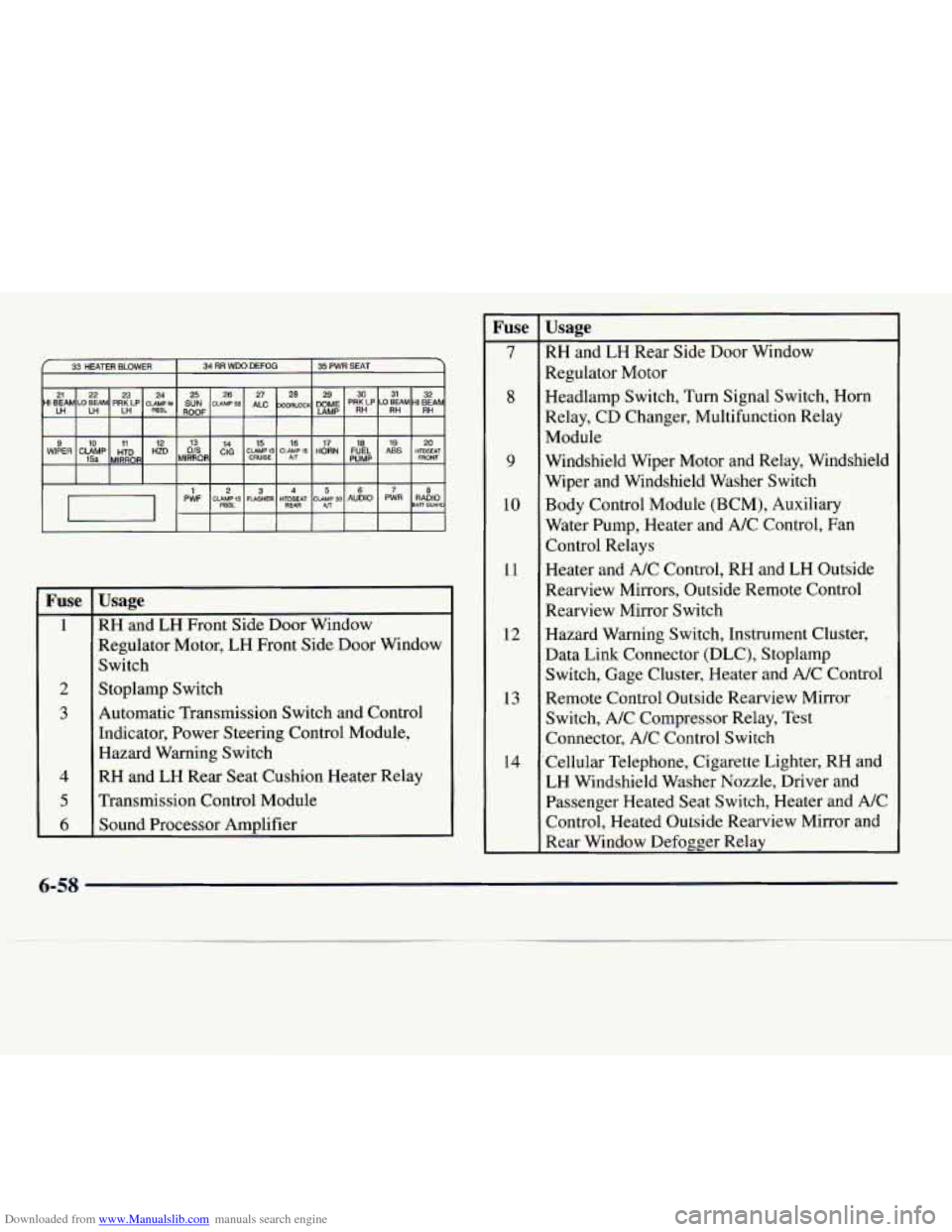
Downloaded from www.Manualslib.com manuals search engine 33 HEATER BLOWER I 34 RR WDO DEFOG I 35PWRSEAT I
WIPER 20 19 18 17 16 15 14 13 12 11 10 9 HIDSEAT ABS FUEL
HORN CLAMP15 CLAMP 15 CIG HZD HTD CLAMP 15a MIRROR CRUISE FRONT PUMP AfT
PWF RADIO PWR AUDIO CLAMP30 HTDSEAT FLASHER CUMPIS 1 8 234567
PESL BAH GUARD All RE4R
Fuse
1
2
3
4
5
6
Usage
RH
and LH Front Side Door Window
Regulator Motor,
LH Front Side Door Window
Switch
Stoplamp Switch
Automatic Transmission Switch and Control
Indicator, Power Steering Control Module,
Hazard Warning Switch
RH and LH Rear Seat Cushion Heater Relay
Transmission Control Module
Sound Processor Amplifier
Fuse
7
8
9
10
11
12
13
14
Usage
RH and LH Rear Side Door Window
Regulator Motor
Headlamp Switch, Turn Signal Switch, Horn
Relay, CD Changer, Multifunction Relay
Module
Windshield Wiper Motor and Relay, Windshield
Wiper and Windshield Washer Switch
Body Control Module (BCM), Auxiliary
Water Pump, Heater and A/C Control, Fan
Control Relays
Heater and A/C Control, RH and
LH Outside
Rearview Mirrors, Outside Remote Control
Rearview Mirror Switch
Hazard Warning Switch, Instrument Cluster,
Data Link Connector (DLC), Stoplamp
Switch, Gage Cluster, Heater and A/C Control
Remote Control Outside Rearview Mirror
Switch, A/C Compressor Relay, Test
Connector, A/C Control Switch
Cellular Telephone, Cigarette Lighter, RH and
LH Windshield Washer Nozzle, Driver and Passenger Heated Seat Switch, Heater and A/C
Control, Heated Outside Rearview Mirror and
Rear Window Defogger Relay
6-58
Page 332 of 338

Downloaded from www.Manualslib.com manuals search engine Nightvision ................................... 4-16
Odometer
.................................... 2-6 1
Odometer. Trip
................................. 2-61
Off-Road Recovery
............................. 4- 12
Oil. Engine
.................................... 6-10
Oil Pressure LighVGage
.......................... 2-72
Outside Temperature Display
....................... 3-3
Overheating Engine
............................. 5- 14
Owner Publications. Ordering
................ 7- 13. 7- 14
Outside Rearview Mirror. Manual Folding
........... 2-47
Paint Spotting. Chemical
........................ 6-53
Park
Automatic Transmission
....................... 2- 19
Shifting Into
................................. 2-25
Shifting Out of
............................... 2-27
Parking AtNight
.................................... 2-11
Brake
...................................... 2-24
Lots
....................................... 2-11
Over Things That Burn
........................ 2-28
With a Trailer
................................ 4-38
Passenger Compartment Air Filter
................... 3-8
Passenger Compartment Air Filter Replacement
....... 6-17
Passenger’s Side Instrument Panel
Fuse Block ........ 6-60
Passenger’s Side Temperature Knob
................. 3-2
Passing
....................................... 4-13
Power DoorLocks
................................... 2-4
Option Fuses
................................ 6-56 Recliner
..................................... 1-8
Remote Control Mirror ........................ 2-47
Retained Accessory
........................... 2-16
Seats
........................................ 1-4
Steering
.................................... 4-10
Steering Fluid
................................ 6-23
Windows
................................... 2-30
Pregnancy. Use of Safety Belts
.................... 1-24
Problems
on the Road ............................ 5-1
Programmable Automatic Door Locks
............... 2-5
Publications. Service and Owner
.............. 7- 13. 7- 14
Radio Reception .............................. 3-21
Radios
.................................. 3.10. 3.13
Rain. Driving
In ................................ 4-17
RAP
......................................... 2-16
ReadingLamps
................................ 2-45
Rear Axle
....................................... 6-19
Door Security Lock
............................ 2-5
Outside Seat Position
.......................... 1-32
Seatpassengers
.............................. 1-32
Window Defogger
............................. 3-9
RearSeats ..................................... 1-10
Rear Turn Signal Lamp, Bulb Replacement
.......... 6-34
Rear Window Lockout
........................... 2-31
Recirculation
................................... 3-5
Reclining Front Seatbacks
......................... 1-6
Refrigerants, Air Conditioning
.................... 6-63
Rearview Mirror, Electrochromic
Daymight
......... 2-46
8-7
Page 334 of 338
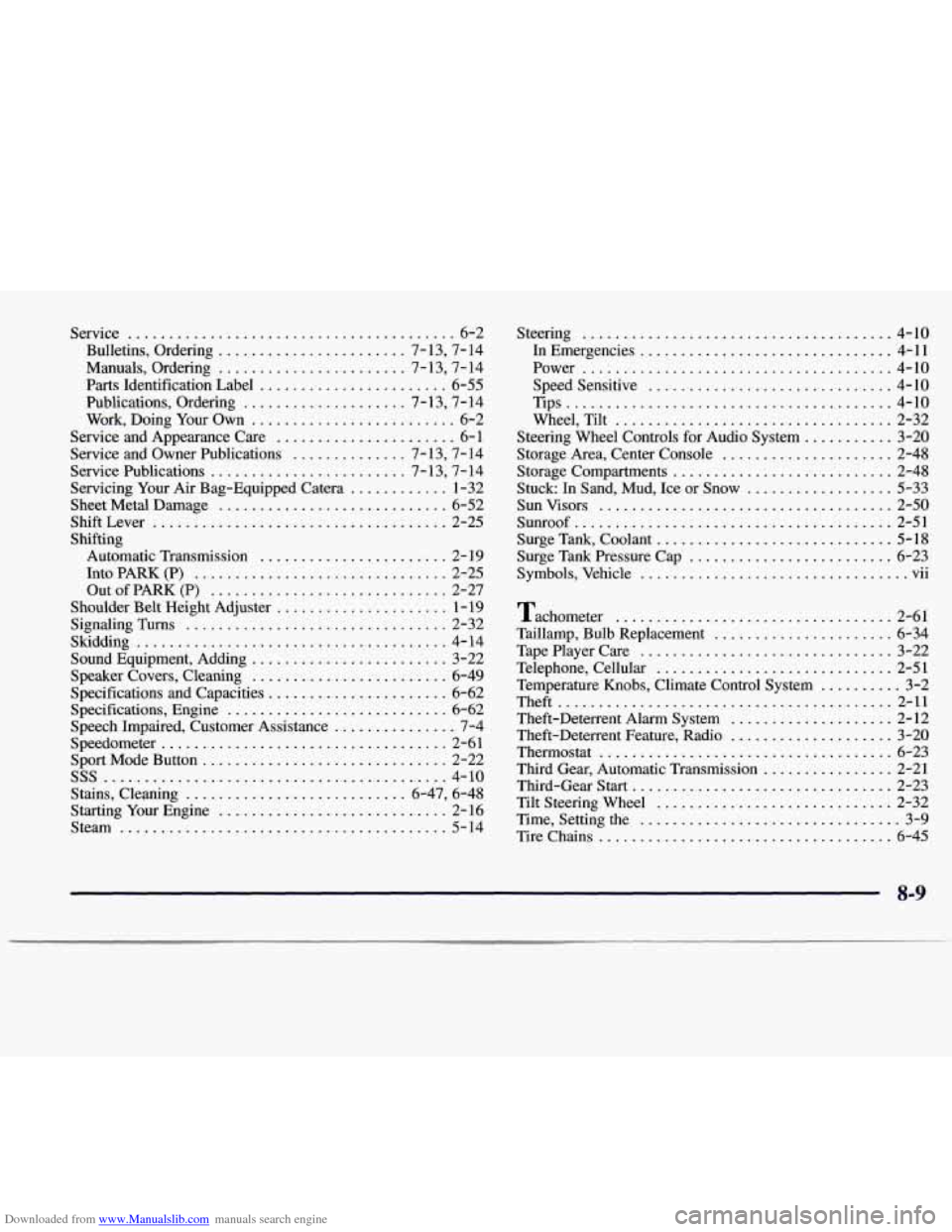
Downloaded from www.Manualslib.com manuals search engine Service ........................................ 6-2
Bulletins. Ordering
....................... 7.13. 7. 14
Manuals. Ordering
....................... 7.13. 7.14
Parts Identification Label
....................... 6-55
Publications. Ordering
.................... 7.13. 7.14
Work. Doing Your Own
......................... 6-2
Service and Appearance Care
................ :. .... 6-1
Service and Owner Publications .............. 7.13. 7.14
Service Publications
........................ 7.13. 7.14
Servicing
Your Air Bag-Equipped Catera ............ 1-32
SheetMetalDamage
............................ 6-52
ShiftLever
.................................... 2-25
Shifting Automatic Transmission
....................... 2- 19
Into PARK (P)
............................... 2-25
Out of PARK (P)
............................. 2-27
Shoulder Belt Height Adjuster
..................... 1-19
SignalingTurns
................................ 2-32
Skidding
...................................... 4-14
Sound Equipment. Adding
........................ 3-22
Speaker Covers. Cleaning
........................ 6-49
Specifications and Capacities
...................... 6-62
Specifications. Engine
........................... 6-62
Speech Impaired. Customer Assistance
............... 7-4
Speedometer
................................... 2-61
SportModeButton
.............................. 2-22
SSS .......................................... 4-10
Stains. Cleaning ........................... 6.47. 6.48
Starting Your Engine
............................ 2- 16
Steam
........................................ 5-14 xeenng
...................................... 4-10
In Emergencies ............................... 4-11
Power
...................................... 4-10
Speedsensitive
.............................. 4-10
Tips
........................................ 4-10
Wheel. Tilt
.................................. 2-32
Steering Wheel Controls for Audio System
........... 3-20
Storage Area. Center Console
..................... 2-48
Storage Compartments
........................... 2-48
Stuck: In Sand. Mud. Ice or Snow
.................. 5-33
Sunvisors
.................................... 2-50
Sunroof
....................................... 2-51
Surge Tank. Coolant
............................. 5-18
Surge Tank Pressure Cap
......................... 6-23
Symbols. Vehicle
................................. vii
Tachometer
.................................. 2-61
Taillamp. Bulb Replacement
...................... 6-34
TapePlayerCare
............................... 3-22
Telephone. Cellular
............................. 2-51
Temperature Knobs. Climate Control System
.......... 3-2
Theft
......................................... 2-11
Theft-Deterrent Alarm System .................... 2-12
Theft-Deterrent Feature. Radio
.................... 3-20
Thermostat
.................................... 6-23
Third Gear. Automatic Transmission
................ 2-21
Third-Gear
Start ................................ 2-23
Tilt Steering Wheel
............................. 2-32
Time. Setting the
................................ 3-9
Tire Chains
.................................... 6-45
8-9